
© Garden Cottage Nursery, 2022

Plans And Planting
Making A Border

Get your self a notebook, use it to keep notes on what you planted where and when as well as a few useful details like flower
colour, season, height and if it needs staking. cross-reference the notebook with your plan. More digitally-minded gardeners could
keep their planting notes in an Excel or Google Docs spreadsheet and then in the future you can take your phone or tablet out into
the garden with you and check up on the progress of your planting.
Keeping good records on planting will make replacing any losses, correcting mistakes, planning maintenance and identifying plants
that have lost labels far easier.

Are you a botanical garden? I didn’t think so… You are under no obligation to have a representative of every sort of plant there is in
your garden, rather you are trying to make something that looks as good as possible with your resources and situation. For best
effect plant larger numbers of fewer varieties, it will both look and work better, so plant groups of 3, 5, 7 or even 9 per variety.
Planting in odd numbers helps to ensure less geometric groupings on planting, which will look better.
We can not reiterate this often enough, plant in threes or more, not individually, but hardly anybody listens!
We sell hundreds of herbaceous of perennials a year, but nearly all of them are bought in one-per-variety, this is bad practice. Stop
it!
We can easily spot when a professional gardener is in The Nursery as they make selections in 3s or more per variety, they know
what they are doing and know that borders both look and work best when planted with plant varieties in broad groups and drifts.
All of this planning rather takes the fun and spontaneity of a visit to the nursery (or if you must a garden centre) and seeing a must
have plant, still you can always buy it and replace something in the border. There will always be something that didn't quite live up
to expectations or that you are just not quite happy with and some regular changes will keep you interested in the border.
You may also wish to ‘theme’ your border; a white border for example, dominated by white flowered plants, variegated and silver
foliage. A hot border with lots of red, orange and yellow flowers. A specific time for your border to be at it’s peak may also be your
theme, an August border for example is likely to have Crocosmia, Hylotelephium and Helenium.
Conditions may also largely dictate what plants you can use; if the soil is always damp you are likely to use Siberian Irises, Astilbe,
Ligularia, Rodgersia and Primula. If it is shady then more spring flowering shade tolerant plants like Pulmonaria, Brunnera and
Hellebores will have to be used as there are few later flowering shade tolerant perennials, e.g. Kirengeshoma, Actaea and Tricyrtis.
Most people lack the room in their small gardens to have several themed borders and must create a balanced bed with interest
over as long a period as possible while trying to get as many of their favourite flowers in as possible in the space allowed.
You do not have to limit a border to classic hardy herbaceous perennials, the addition of ornamental grasses, evergreen perennials
and small shrubs as well as showy annuals and half-hardy perennials can do much to enhance the texture, look, feel and to extend
the season of interest of a border. Mixing shrubs and herbaceous in one border is known as a ‘Mixed Border’.
Much has been written about colour, symmetry, layout and impact of borders. The choice of how you want your border to look is
entirely down to you: A Christopher Lloyd rowdy riot of colours or a Gertrude Jekyll soothing symphony, a formal Edwardian
'English' style herbaceous border or a modern matrix planting, with bold verticals, grasses, metallic silvers, purples and blues.
All of these approaches have their place in gardens and have their vehement opponents and proponents. You cannot please
everyone, so just try to please yourself.
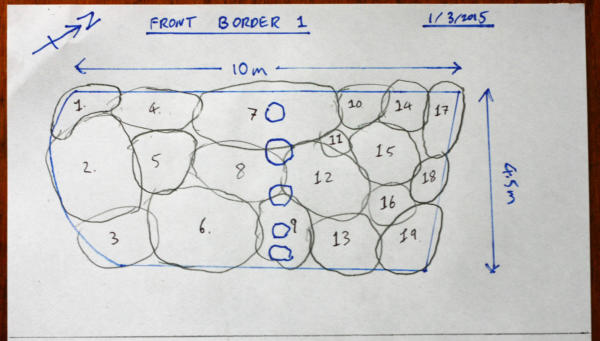
There are a few golden rules for planting any border, though as they say rules a made to be broken!
The plants at the front and edges should be the shortest running up to the highest at the back or the centre if it is a two sided
border. This slopping layout ensures maximum visibility for all plants without the plants in front obscuring those behind. Varying the
heights of adjoining plants slightly will give a more naturalistic feel, rather than a smooth wall of colour.
In most soils a herbaceous border should be lifted, the plants split and the border re-dug every 3-5 years. this will refresh soil and
relieve compaction, renew congested plants and improve the flowering of many types and give you an opportunity to change things
round.
Walking on and digging a saturated soil will do more harm than good, wait for the soil to dry-out a bit first.
We always have a wide range of herbaceous perennials to suit all tastes and situations, feel free to come and ask us for advice.
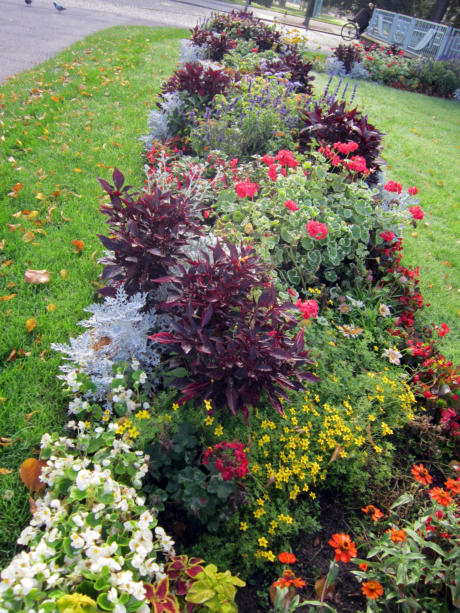

A narrow border in Strasbourg made entirely of seasonal
bedding plants. A riotous mix of colour, at first perhaps
appearing randomly mixed but then you notice a repeating
but slightly varying theme to the planting pattern as it goes
along the length.
The strip of grass between the pavement to the border has a
similar width to the border itself and serves to protect the
plants from unwanted pedestrian damage and to tie-in the
border to the parkland beyond.
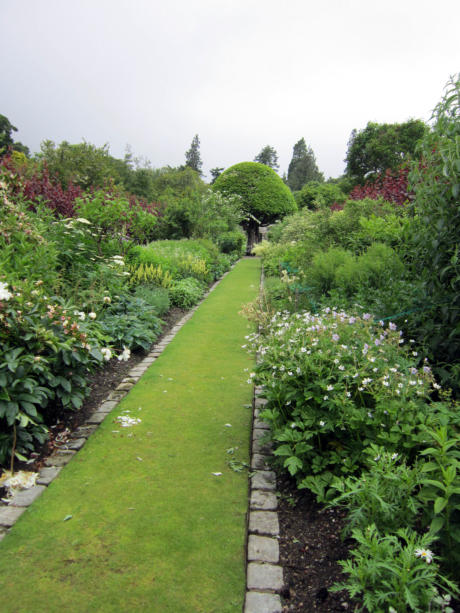
A pair of mixed borders at Crathes Castle, Aberdeenshire.
Filled with mostly white or pale flowers peaking in July-
August. The ‘V’ shape of the two borders gives a pleasing
symmetry and draws the eye to the sculpted tree at the end.
Note the stone sets that edge the border, they reduce the
erosion of the turf edge, making for a clearer edge and help
keep a cleaner edge from a mowing point of view as low-
growing plants at the border front will be less likely to be
ensnared in a mower.
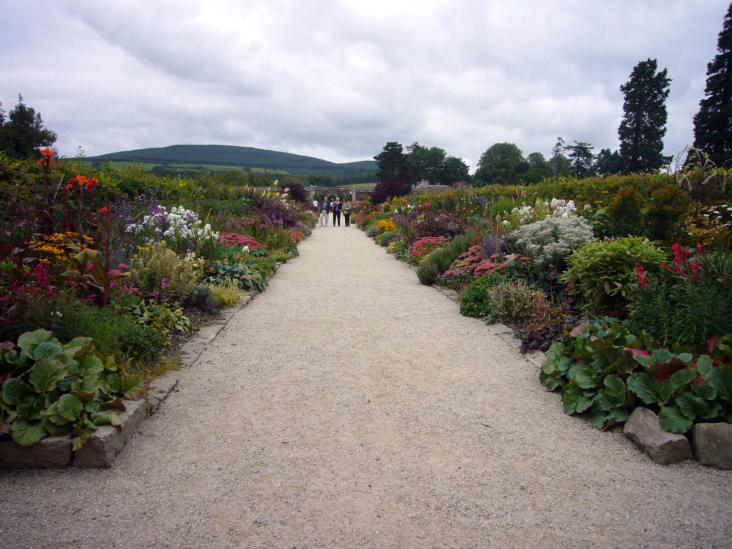
An excellent pair of large borders at Powerscourt in Co Wicklow.
The gentle slope of the borders both reflect and draw the eye to the rolling landscape beyond.
The backing of the borders with hedges give both a structural element in winter and shelter from
cross winds in summer that may batter or flatten taller perennials.











© Garden Cottage Nursery, 2021

Plans And Planting
Making A Border

Get your self a notebook, use it to keep notes on what you
planted where and when as well as a few useful details like
flower colour, season, height and if it needs staking. cross-
reference the notebook with your plan. More digitally-minded
gardeners could keep their planting notes in an Excel or Google
Docs spreadsheet and then in the future you can take your
phone or tablet out into the garden with you and check up on
the progress of your planting.
Keeping good records on planting will make replacing any
losses, correcting mistakes, planning maintenance and
identifying plants that have lost labels far easier.

Are you a botanical garden? I didn’t think so… You are under no
obligation to have a representative of every sort of plant there is
in your garden, rather you are trying to make something that
looks as good as possible with your resources and situation.
For best effect plant larger numbers of fewer varieties, it will
both look and work better, so plant groups of 3, 5, 7 or even 9
per variety. Planting in odd numbers helps to ensure less
geometric groupings on planting, which will look better.
We can not reiterate this often enough, plant in threes or more,
not individually, but hardly anybody listens!
We sell hundreds of herbaceous of perennials a year, but nearly
all of them are bought in one-per-variety, this is bad practice.
Stop it!
We can easily spot when a professional gardener is in The
Nursery as they make selections in 3s or more per variety, they
know what they are doing and know that borders both look and
work best when planted with plant varieties in broad groups and
drifts.
All of this planning rather takes the fun and spontaneity of a visit
to the nursery (or if you must a garden centre) and seeing a
must have plant, still you can always buy it and replace
something in the border. There will always be something that
didn't quite live up to expectations or that you are just not quite
happy with and some regular changes will keep you interested
in the border.
You may also wish to ‘theme’ your border; a white border for
example, dominated by white flowered plants, variegated and
silver foliage. A hot border with lots of red, orange and yellow
flowers. A specific time for your border to be at it’s peak may
also be your theme, an August border for example is likely to
have Crocosmia, Hylotelephium and Helenium.
Conditions may also largely dictate what plants you can use; if
the soil is always damp you are likely to use Siberian Irises,
Astilbe, Ligularia, Rodgersia and Primula. If it is shady then
more spring flowering shade tolerant plants like Pulmonaria,
Brunnera and Hellebores will have to be used as there are few
later flowering shade tolerant perennials, e.g. Kirengeshoma,
Actaea and Tricyrtis.
Most people lack the room in their small gardens to have
several themed borders and must create a balanced bed with
interest over as long a period as possible while trying to get as
many of their favourite flowers in as possible in the space
allowed.
You do not have to limit a border to classic hardy herbaceous
perennials, the addition of ornamental grasses, evergreen
perennials and small shrubs as well as showy annuals and half-
hardy perennials can do much to enhance the texture, look, feel
and to extend the season of interest of a border. Mixing shrubs
and herbaceous in one border is known as a ‘Mixed Border’.
Much has been written about colour, symmetry, layout and
impact of borders. The choice of how you want your border to
look is entirely down to you: A Christopher Lloyd rowdy riot of
colours or a Gertrude Jekyll soothing symphony, a formal
Edwardian 'English' style herbaceous border or a modern matrix
planting, with bold verticals, grasses, metallic silvers, purples
and blues.
All of these approaches have their place in gardens and have
their vehement opponents and proponents. You cannot please
everyone, so just try to please yourself.
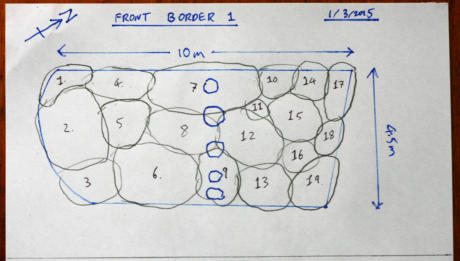
There are a few golden rules for planting any border, though as
they say rules a made to be broken!
The plants at the front and edges should be the shortest running
up to the highest at the back or the centre if it is a two sided
border. This slopping layout ensures maximum visibility for all
plants without the plants in front obscuring those behind.
Varying the heights of adjoining plants slightly will give a more
naturalistic feel, rather than a smooth wall of colour.
In most soils a herbaceous border should be lifted, the plants
split and the border re-dug every 3-5 years. this will refresh soil
and relieve compaction, renew congested plants and improve
the flowering of many types and give you an opportunity to
change things round.
Walking on and digging a saturated soil will do more harm than
good, wait for the soil to dry-out a bit first.
We always have a wide range of herbaceous perennials to suit
all tastes and situations, feel free to come and ask us for
advice.


A narrow border in Strasbourg made entirely of seasonal
bedding plants. A riotous mix of colour, at first perhaps
appearing randomly mixed but then you notice a repeating but
slightly varying theme to the planting pattern as it goes along the
length.
The strip of grass between the pavement to the border has a
similar width to the border itself and serves to protect the plants
from unwanted pedestrian damage and to tie-in the border to the
parkland beyond.

A pair of mixed borders at Crathes Castle, Aberdeenshire. Filled
with mostly white or pale flowers peaking in July-August. The ‘V’
shape of the two borders gives a pleasing symmetry and draws
the eye to the sculpted tree at the end. Note the stone sets that
edge the border, they reduce the erosion of the turf edge,
making for a clearer edge and help keep a cleaner edge from a
mowing point of view as low-growing plants at the border front
will be less likely to be ensnared in a mower.
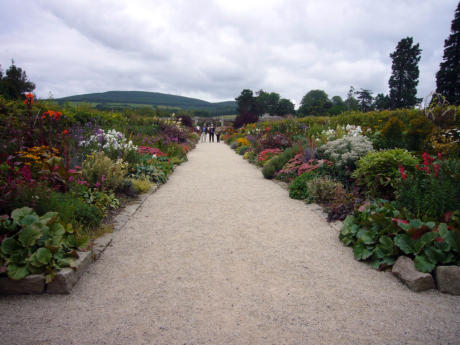
An excellent pair of large borders at Powerscourt in Co Wicklow.
The gentle slope of the borders both reflect and draw the eye to
the rolling landscape beyond.
The backing of the borders with hedges give both a structural
element in winter and shelter from cross winds in summer that
may batter or flatten taller perennials.

























